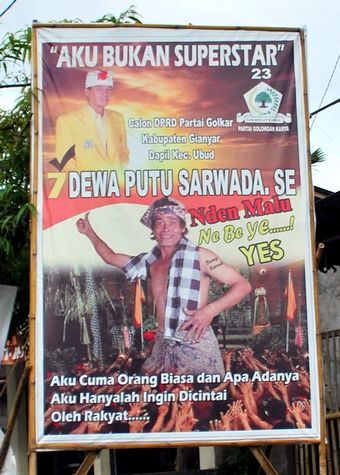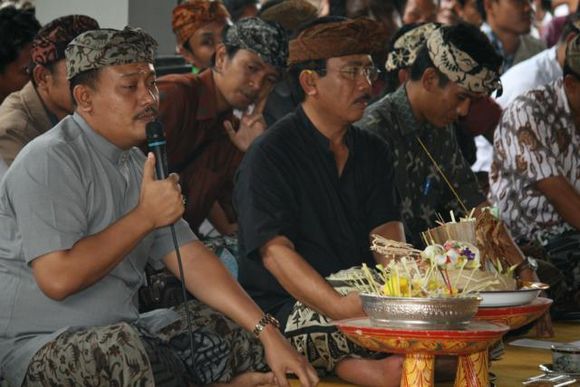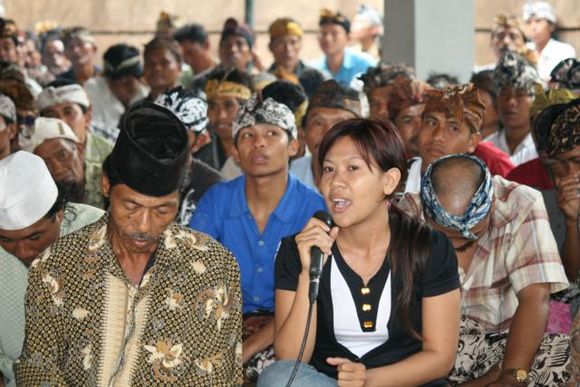Bodrek Arsana
Speaking up for women: questions and answers at a simakrama campaign eventThe Linggih Center |
I Gede Arta, 45 years old, had just parked his car after arriving home when his son started waving a small flag with the symbol of PDI-P, the dominant political party in Bali. ‘Where did you get that from?’ asked Gede. His eleven year old child said that he and his friends had just been invited to attend a simakrama (socialisation) for a legislative candidate from the party in the family temple of a different clan. ‘I was invited by Pak Wayan Wira. He said there was a gathering and that we’d get food and Rp15,000,’ recounted Agus politely. Gede Arta’s face was red with suppressed anger. ‘Tomorrow you’re not allowed to go again. Children aren’t allowed to get involved in politics. I’ll call Pak Wayan to explain,’ barked Gede. Straightforwardly, Agus replied, ‘I’m not involved in politics; I just went for the food and the money.’ Plenty of people at the grassroots in Bali have this view of the elections. Others see it as a potential source of division. Yet other see it as a Karya Agung, or grand festival, involving lots of noise that requires sacrifice and leaves a lot mess behind it.
Billboards, posters and banners
 |
No superstar: advertisement for a legislative candidate in BaliMila Shwaiko |
From January to April 2009, the flags of the political parties and pictures of the legislative candidates filled every corner of Gede Arta’s village and neighbourhood. Not only the roads, but the trees and public infrastructure, such as electricity poles, village meeting space, bale banjar (community meeting halls), and even walls, were plastered with party symbols and posters of the candidates, despite regulations forbidding advertising material on public facilities or holy places. ‘I’m overwhelmed to see this. If they could, maybe they’d stick their party flags and billboards to the sky so that theirs would be the highest. Maybe they should invite the god of the skies to campaign,’ joked Gede Arta. According to regulations, the campaign had not even begun in January, but banners, flags, posters, and billboards bearing political party insignia and the pictures of legislative candidates were everywhere in Bali, as with the rest of Indonesia.
The political tumult was due to the general election held on 9 April 2009. A large number of political parties competed in the 2009 election: 38 at the national level and 6 local parties in Aceh, ensuring that General Election Commission (KPU), as the election implementer, was kept busy with party verification and managing the schedule.
This election was also unique because it was the first year that individual legislative candidates won by popular vote, a procedure that followed a decision of the Constitutional Court in 2008. In a popular vote system, a candidate wins based on the number of votes that he or she wins as an individual, not on the basis of the place he or she occupies on a list determined by the party, as in past elections. In past elections only the parties had to campaign; in 2009 the legislative candidates also had to actively sell themselves to win. The effect was clear: banners, billboards and posters describing the candidates filled every public space.
Conflict in the villages
‘The idea of a general election is good, so that democracy can quickly develop. This is the era of reformation, a time of freedom. However, it is the leaders at the bottom like me who are confused,’ said Gede Arta. Gede Arta is the bendesa adat (traditional leader) of a village in Gianyar district. He has led this traditional village institution uninterrupted for fifteen years. Gede Arta is the third generation to be bendesa after his grandfather and father. ‘As a leader in the village, it’s easy-hard. Hard because we deal with many people with different opinions and easy because we know everyone and problems are often solved through discussion. Until now, there has only been one big conflict in our village. This led to disorder, but the case was taken over by the district head and was resolved, said Gede.
Every election triggers conflict between village inhabitants, though the seeds of conflict already exist
However, in the run up to the 2009 election, Gede Arta admitted to being worried about the atmosphere in his village. ‘I know this election is important, as the officials on TV say, but I’m also confused because it ignites conflict between community members. It sounds sweet, saying that differences are beautiful, but sometimes it’s only sweet in the mouth. Implementation in the field is messy. The people in our village say it is like dogs going after bones, bones with no meat on them.’
According to Gede, every legislative and regional head election triggers conflict between village inhabitants. Of course, the seeds of conflict already exist and include inheritance issues within families, or competition between community figures from different clans. ‘In my opinion, general elections and mass convoys are like putting a match to dry leaves. The seeds of enmity exist and then you add the problems of life, which are becoming harder due to a bad economy, and clashes happen so easily,’ said Gede.
The people in our village say it is like dogs going after bones, bones with no meat on them
With this reasoning, Gede Arta called Pak Wayan, his neighbour, who is part of the ‘success team’ for a legislative candidate. ‘I don’t want to obstruct anyone’s rights, but our village already made an agreement to hand over issues related to the election to the village. The essence of the agreement was that the village would facilitate things if there was a legislative candidate or party who wanted to hold a socialisation event in our village. If this is violated, there are sanctions,’ explained Gede Arta.
In Bali the campaign is wrapped in ‘traditional culture’. This includes the simakrama, which literally means a face-to-face, informal meeting or a gathering of community members with ties within a village community or clan. While the essence of the simakrama held during elections is to campaign for a candidate or party, because the participants wear traditional clothing and sometimes meet in family temples or bale banjars, the Election Monitoring Body is not able to take action against them. ‘We are always in the wrong, if we take action, they say it is a clan meeting, despite the fact that someone has invited people to vote for a certain candidate or party’, said Wayan Wena, a member of the Election Monitoring Body of Bali.
 |
Gde Sumarjaya Linggih of the Golkar party campaigns for a seat in the national legislatureThe Linggih Center |
Wayan Wiranata is a relation of Gede Arta. Wayan was also a major competitor of Gede Arta in the fight to be bendesa. The families of Gede Arta and Wayan Wira are the most high profile in the village. According to Ketut Kandri, a villager I met, while there is still a family tie between them, the two families have a long history of competition which affects all the village’s inhabitants.
Wayan Wira, when I met him at his house, looked emotional. Wayan told me about the decision made by the village meeting which insisted that all campaign events had to be coordinated by the village leadership: ‘The village’s decision was Gede Arta’s work. He wanted it for his own benefit, to win mekisa style, he said. Mekisa refers to a win in cockfighting when the cock wins without fighting or even coming out of the cage. ‘If a legislative candidate or party wants to come and campaign in the village, it has to go through him because he’s the bendesa adat,’ added Wayan angrily. Wayan accused Gede Arta of acting as a promoter for candidates or parties who came to him bringing money. In Wayan’s opinion, the time has passed for obstructing people’s political choices. ‘That was the New Order era. All aspirations had to be the same. We were pressured and afraid. Now it’s a time of freedom for people to decide on their opinions for themselves. Traditional affairs can’t be entwined with politics. We can’t repeat the saga of Golkar during the New Order,’ urged Wayan.
Apathy in the community
The competition, conflict, and struggle for influence not only play out at the elite level in the cities, but also among the elite in the village. However, the community has its own way of making sense of the 2009 election. In the 1999 and 2004 elections, there was a euphoric response on the part of the masses that was visible in many convoys and campaigns; in 2009 the community didn’t look that interested. Wayan Wira admitted this: ‘Now it’s hard to get a mass of people. Before, 500 would attend a socialisation session, but now even around 100 for a banjar-level meeting is good. The cost to get a big group is also high; in 1999 they would come for a packaged rice meal. In 2009, they ask first how much money they’ll receive and if they feel it’s a large enough sum they come,’ said Wayan.
The competition, conflict, and struggle for influence not only play out at the elite level in the cities, but also among the elite in the village
Nyoman Mulyana is a politically active youth leader in the village led by Gede Arta. He says that he and his friends are very selective in accepting invitations to attend party and legislative candidate socialisations. ‘They only remember us once every five years, so we have to sell ourselves dear. Parties and legislative candidates are makers of promises that may not be kept,’ said Nyoman. While chatting with Nyoman, a friend of his, Made Polih, came by. ‘Elections are like temple rituals’, he said, ‘crowded and noisy. Everyone is involved, everyone volunteering. There’s conflict, intrigues between temple guardians, displays of wealth and influence and those hunting for profit. Afterwards, the leftovers of the ritual are shared.’
Elections as Balinese rituals
In Bali’s cosmology, the election is often understood as a karya, or a big ritual involving the cosmology and cosmogony of the Balinese people. In Bali, the month of March was filled with holy days, including Galungan on 18 March, Nyepi on 26 March, and Kuningan on 29 March. The Karya Agung ritual, or the 2009 election, fell on the day of the full moon or purnama, which marks the start of many festivals in Bali.
The closer the election, the hotter the political atmosphere became in Bali, as in other parts of Indonesia. On 16 March the Bali Post, with a somewhat sensational headline, wrote ‘the first blood has spurted forth in Tabanan,’ in reference to an attack by a group thought to be supporters of PDI-P against a Democrat Party task force that had been patrolling and checking Democrat Party billboards, which, according to the head of Tabanan Democrat Party Branch, were often damaged or stolen. Gede Arta, the bendesa adat of the village, remembered that the Karya Agung ritual always needs a sacrifice as an offering to the butha kala (otherworldly beings) so they don’t disturb the ritual. ‘Maybe the incident in Tabanan won’t be the last; there will probably be other sacrifices. What is clear is that the officials will celebrate after the election while the tired people are still cleaning up after the Karya Agung is over.’ ii
Bodrek Arsana (Bodrek.Arsana@gmail.com) is a freelance journalist and activist based in Bali and Yogyakarta. This article was translated by Mila Shwaiko.
